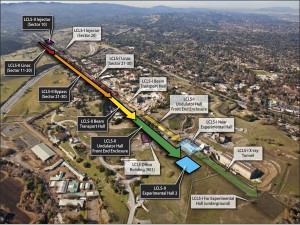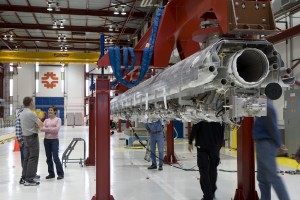
The superconducting radio-frequency technology at SLAC’s LCLS II light source is owed in part to developments made by the International Linear Collider. Credit: SLAC
The superconducting technology at the heart of the future International Linear Collider is one of the outstanding innovations of the machine’s design. Of international heritage, ILC-type superconducting acceleration has borne American offspring, including technology for the newest kid on the block, SLAC National Accelerator Laboratory’s light source LCLS II, scheduled to begin operations in late 2018.
“ILC development is a breeding ground for LCLS II,” said Hasan Padamsee, head of Fermilab’s Technical Division and renowned SCRF expert. “Without that available technology, you couldn’t dream of applications that are now spread around for different purposes.”
Central to the technology are superconducting cavities – niobium structures through which particles hurtle at close to the speed of light. To be superconducting, the cavities need to be kept cold, so researchers work diligently on cryogenic systems to refrigerate them efficiently.
LCLS II will use superconducting radio-frequency technology, or SCRF, to generate extremely bright electron beams – not to investigate quarks and leptons, as the ILC will do – but to take snapshots of cellular structures and chemical reactions.
“It’s a remarkable example of different corners of science in our country coming together for a common purpose,” said SLAC’s Marc Ross, cryosystems manager for LCLS II and former Americas region project manager for the Global Design Effort, the original governing entity for the ILC.
Developments in superconducting accelerator technology at the ILC has begotten innovations in other accelerators for nuclear physics, materials sciences and in high-intensity proton accelerators for neutrino beams or muon beams.
International roots
Of course, the ILC’s superconducting radio-frequency technology has its own ancestry.
SCRF had significantly advanced the field of particle physics around the world by 2004, when an international group of scientists was deciding on the acceleration technology to be implemented in a large, yet-to-be-named future linear collider. They had recognised decades of successful SCRF performance at other previous electron-positron colliders around the globe: CESR at Cornell University in the United States, FLASH at Germany’s DESY, KEK-B and TRISTAN at Japan’s KEK, and LEP II at CERN in France and Switzerland.
There is also the ILC’s close relative at DESY, the European X-ray Free-Electron Laser, or European XFEL. Of more modest scale than the ILC – it calls for 800 cavities compared with the ILC’s 16,000 – it has served as the ILC’s SCRF training ground.
“The idea was that, unless you had a more practical twin to serve as a precursor to the ILC, you really wouldn’t be able to demonstrate that you could build a 16,000-cavity machine,” Padamsee said.
The accelerator community designed and began constructing the superconducting XFEL, planned to be commissioned in 2016. The accelerator will use X-rays to probe molecular structures and extreme states of matter. The free exchange of technological advances between it and the ILC pushed the design of both machines to the cutting edge. The advances would be inherited by future particle accelerators.
The ILC would also bestow another gift to the next SCRF generation, one that only a machine of its size could offer: an infrastructure necessitated by its incredible scale.
American heritage

Early on, the U.S. high-energy physics community built an infrastructure to accommodate the large scale of the International Linear Collider. Pictured here is an ILC-type cryomodule at one of Fermilab’s Industrial Complex buildings. Jefferson and SLAC laboratories, as well as institutions such as Cornell University, were a part of the U.S. infrastructure for ILC SCRF. Credit: Fermilab
LCLS II and the ILC look nothing alike. LCLS II’s accelerator complex is a tenth of the length of the proposed 31-kilometre International Linear Collider. It will accelerate particles to a far lower energy – 4 GeV versus 500 GeV. LCLS II cavity specifications are very different from those of ILC cavities. Finally, LCLS II will not probe fundamental bits of matter, as the ILC will, but larger-scale, molecular structures.
Nevertheless, LCLS II is taking advantage of ILC SCRF technology to graduate from its previous life as a normal-conducting accelerator to a superconducting one. It also draws on the connections formed by the ILC community – connections between scientific disciplines, between economic sectors, between institutions.
Early on, the ILC connections were born of necessity to help manage its unprecedented scale. Seeing the need for a wide infrastructure to accommodate it, the high-energy physics community got to work.
In 2007, the US community started gearing up to build prototypes for the now officially named ILC. It began tooling up Fermilab in Illinois, Jefferson Lab in Virginia and SLAC in California, as well as university partners such as Cornell University, to advance SCRF research specifically for the future collider. Because US researchers needed a way to fabricate enough cavities to fill a tunnel nearly one-and-a-half times the length of Manhattan, the community also formed important relationships with industry to enable cavities’ mass production.
“The successful prototyping for ILC provided a proof of principle – it mitigated the risk of LCLS II,” Ross said. “We know how much these things cost. LCLS II can go ahead with this technology. It’s a dream come true.”
LCLS II is planned to start operating in late 2018. By then, Ross says, SCRF research in the United States will likely have matured considerably. Fermilab and Jefferson Lab both currently contribute to LCLS II R&D at SLAC.
“When we’re done, we’ll be able do this for a future cryomodule and to connect innovations in the way a cavity is built,” Ross said. “LCLS II is providing the US system with an opportunity to flex its muscle, so to speak.”
LCLS II isn’t the only project in the United States taking advantage of the acceleration of SCRF development that the ILC helped establish. Fermilab’s future PIP-II, a plan for upgrading the lab’s accelerator complex to deliver high-intensity particle beams, will borrow from ILC advances in SCRF.
Global dissemination
The infrastructure for the international collider isn’t limited to the United States, of course. Laboratories around the world – notably DESY, IHEP in China, KEK – have promoted and continue to nurture SCRF research globally, both for the ILC and for future accelerators.
The ILC’s SCRF technology and network has transferred across geographic borders and scientific disciplines, perpetuating its technological genes to help fulfil humankind’s penchant for discovery. As researchers press ahead on SCRF advances and build its attendant infrastructure, superconducting radio-frequency technology in the United States will have plenty of other opportunities to apply its strength – even beyond high-energy physics and the ILC.
Stay tuned for a future article on SCRF developments for LCLS II.

Recent Comments